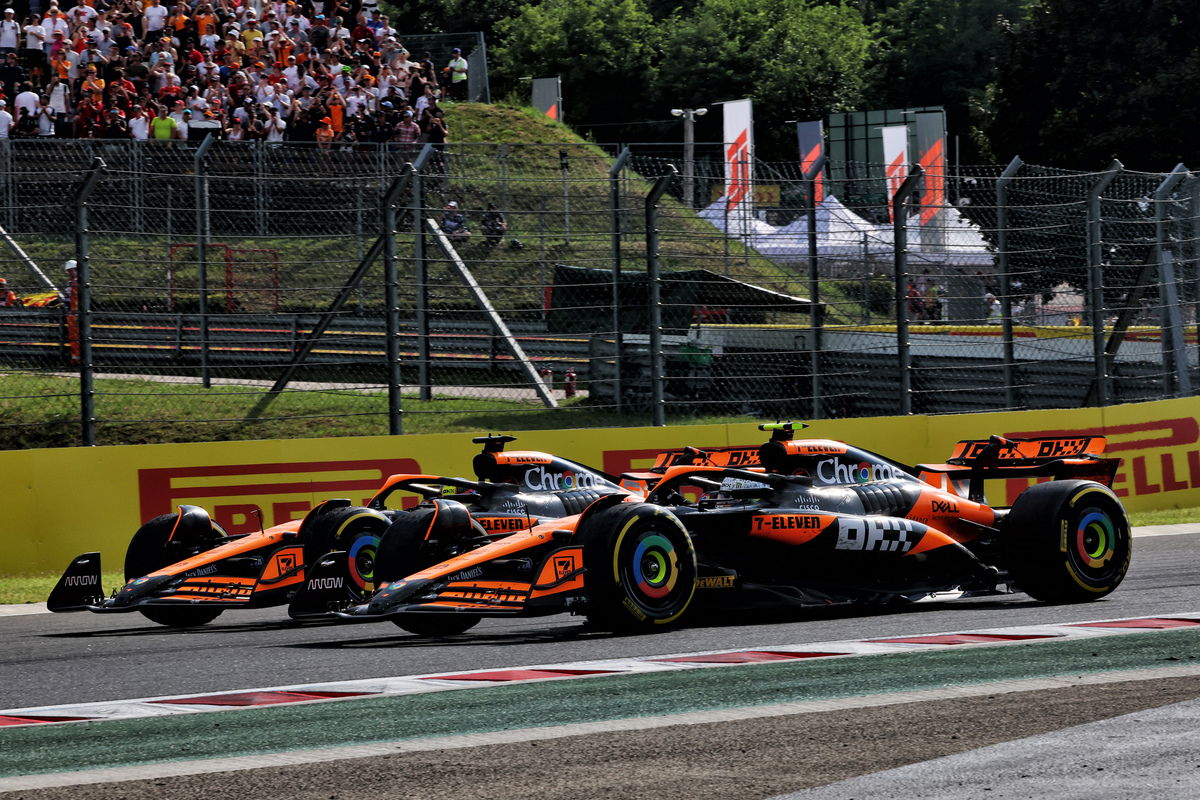

Oscar Piastri won the race ahead of Norris in a strong showing for McLaren having locked out the front row in qualifying.
However, it was far from plain sailing during the race with tension on the pit wall in the latter stages.
At the final round of stops, second-placed Norris was exposed to a potential undercut from Lewis Hamilton in third.
To cover off that threat, McLaren pitted the pole sitter, a move which saw him undercut Piastri and leave him with the race lead once the Australian boxed two laps later.
The intent was to then move Norris aside and restore the previous order, a request that was not well received – though was eventually complied with.
According to Stella, Norris’ reluctance to follow team orders is a positive trait for a racing driver, but one that doesn’t override the team’s underlying culture.
“I know that when you have a race driver and you deal with a race driver, sometimes you have to communicate to all the sides that exist inside a race driver,” the McLaren team principal explained.
“But I know enough and well enough that inside Lando we have the race driver and the team player.
“These two elements came along perfectly today to generate what was the right thing to do for the team, for Oscar and for Lando.
“So it’s a situation that I think it proves, it shows and it demonstrates once again what it means to be part of the McLaren Formula 1 team,” he added.
“These are the values. Sometimes they conflict with some instinct of a race driver, but the values, the culture and the good for the team stays always the most important thing.”
Ahead of the race, the team discussed the potential use of team orders as part its regular briefing session.
It’s a point that was raised to Norris over the radio as discussions over allow Piastri through took place.
“We have discussions with our race drivers before every race,” Stella said.
“The discussion we have is about our principles. Because it’s very difficult to manage Formula 1 races if you only talk about rules.
“Like, “oh, the car ahead has priority at the stop”, you really risk to box yourself into a problem, like every driver desperately trying to be ahead at the first corner because then they want the priority.
“We talk about our principles going racing. One principle, just to make an example, I don’t want to discuss too much, but this one is simple, is the interest of the team comes first.
“If you mess up on this matter, you cannot be part of the McLaren Formula 1 team. That’s the principle.
“And then we reaffirm some of our ways in which we collaborate, the messages, for instance, that we use in case we need to solve situations like this. And that’s what we do before the race. ”
The decision to pit Norris when it did, on Lap 45, was made in the knowledge that it could leave the team in an awkward position with its drivers in the latter stages.
Though it held a somewhat comfortable advantage, Stella was keen to ensure there was no undue pressure on the pit crew that could adversely affect the outcome of the race.
Instead, he felt that obligation was better carried by the team’s management, and its drivers.
“I just did not want to have a situation at the pitstop where there’s a problem with a nut, there’s a problem with the execution that puts us behind a Mercedes or a Ferrari,” he explained.
“We have seen with Verstappen today what can happen and Verstappen would have had the tyres much fresher than the guys ahead.
“So I think we would be talking something else if that was the case like it happened to Verstappen.
“I know that for the media, I know that for watching on TV this becomes a story, but for us internally, this becomes part of the way we go racing and that’s why we invest so much in culture, in values, and in the mindset because we want to be able to manage this situation if we want to be in the championship with Lando, with Oscar, and with McLaren.
“We knew that by going first with Lando that could have been the situation, but we wouldn’t have done it if we weren’t sure that this would be fixed,” he added.
“I think today, because we are at the Hungaroring and because it was so hot, there were two variables that we really wanted to get right.
“The first one, we didn’t want to pit too early because the tyres were degrading a lot and we didn’t want to run out of tyres should Verstappen become a problem at the end of the race. And therefore, we just wanted to delay the pitstop as much as possible.
“The second element is that you can have a problem at the pitstop, so you need to go safe from a pitstop point of view.
“Do you want to pit only when you have three seconds? Because then you know what happens that all the pressure goes on the pit crew.
“I don’t want, in a race like today, that the responsibility goes to the pit crew.
“I’d rather take the responsibility at the pit wall, secure the P1, P2 and then we manage the situation between the pit wall.”
Norris ultimately slowed at the end of Lap 67 to hand the race lead back to Piastri, who went on to claim his first F1 victory.
McLaren now sits 51 points in arrears of Red Bull Racing in the constructors’ championship, with Norris 76 points shy of Verstappen in the drivers’ title.






















Discussion about this post